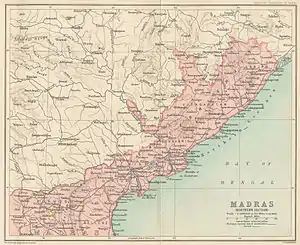Northern Circars
The Northern Circars (also spelt Sarkars) was a division of British India's Madras Presidency. It consisted of a narrow slip of territory lying along the western side of the Bay of Bengal from 15° 40′ to 20° 17′ north latitude,[1] in the present-day Indian states of Andhra Pradesh and Odisha.
| Northern Circars | |||||||||
|---|---|---|---|---|---|---|---|---|---|
| Division of British India | |||||||||
| 1823–1947 | |||||||||
 Flag | |||||||||
 The Northern Circars shortly after their occupation by the British | |||||||||
| Area | |||||||||
| • Coordinates | 17.45°N 83.00°E | ||||||||
• | 78,000 km2 (30,000 sq mi) | ||||||||
| History | |||||||||
• The British buy the rights over the Circars | 1823 | ||||||||
| 1947 | |||||||||
| |||||||||
The annexation by the British of the Northern Circars deprived Hyderabad State, the Nizam's dominion, of the considerable coastline it formerly had, assuming the shape it is now remembered for: that of a landlocked princely state with territories in Central Deccan, bounded on all sides by British India.[2]
Etymology
Circar was an English spelling of sarkar, a Mughal term for district (a subdivision of a subah or province), which had been in use since the time of Sher Shah Suri (1486–1545).[1][3][4] "Northern Circars" meant the northern districts of the Nizam's dominion.
Eventually "Circar" also acquired the meaning of "British Sarkar", i.e., the British government.[5] Hence, "Sarkar districts" could also be understood as the districts under the administration of the British government.
Geography
The Northern Circars were five in number: Chicacole (Srikakulam), Rajahmundry, Eluru, Kondapalli and Guntur, with a total area was about 30,000 square miles (78,000 km2)[1] when Nizam initially lost control of them to the Europeans.[6]
In the main, the region at various points of time corresponded to the northern and the central parts of Coastal Andhra region of Andhra Pradesh, including the whole of present-day districts of Guntur, Krishna, East Godavari, West Godavari, Visakhapatnam, Vijayanagaram and Srikakulam of Andhra Pradesh. It also included parts of the present day Prakasam district of Andhra Pradesh, Ganjam, Gajapati, Rayagada, Koraput, Nabarangapur and Malkangiri districts of Odisha and a few parts of the Mulugu and Kothagudem districts of Telangana.
History

The region was invaded by the Bahmani Sultanate in 1471; in 1541 the Bahmanis conquered Kondapalli, and nine years later they extended their conquests over the Guntur and Masulipatam districts.[1] They appear to have acquired only an imperfect possession of the country, as it was again wrested from the Hindu princes of Odisha about the year 1571, during the reign of Ibrahim, of the Qutb Shahi dynasty of Golconda and Hyderabad.[1] In 1687 the Circars were added, along with the Golconda Sultanate, to the extensive empire of Aurangzeb.[1]
In 1724, Mir Qamar-ud-din Khan was appointed the governor of Hyderabad, with the title Nizam al Mulk. He came to be known as the Nizam of Hyderabad, its de facto ruler. The fourth Nizam Salabat Jang, a son of the Nizam al Mulk, who was indebted for his elevation to the throne to the French East India Company, granted the district of Kondavid (in the Guntur district) to the French in return for their services, and soon afterwards granted the other circars as well.[1] In 1759, through the conquest of the fortress of Masulipatnam, the maritime provinces from the river Gundlakamma to the Chilka Lake were transferred from the French to the British.[1] But the British left them under the administration of the Nizam, with the exception of Masulipatnam, a valuable port, which was retained by the British.[1]
In 1765 Lord Robert Clive obtained from the Mughal emperor Shah Alam II a grant of the five Circars.[1] The fort of Kondapalli was seized by the British as an opening move. On 12 November 1766 a treaty of alliance was signed with Nizam Ali Khan by which the British undertook to maintain troops for the Nizam's assistance.[1] By a second treaty, often referred to as the Treaty of Masulipatnam, signed on 1 March 1768, the Nizam acknowledged the validity of Shah Alam's grant and resigned the Circars to the British East India Company, receiving as a mark of friendship an annuity of £50,000.[1] Guntur, as the personal estate of the Nizam's brother Basalat Jang, was excepted during his lifetime under both the treaties.[1] He died in 1782, but it was not till 1788 that Guntur came under British administration. Finally, in 1823, the claims of the Nizam over the Northern Circars were bought outright by the Company, and they became a British possession.[1][7]
The Northern Circars were governed as part of Madras Presidency until India's independence in 1947, after which the presidency became India's Madras State. The northern, Telugu-speaking portion of Madras state, including the Northern Circars, was detached in 1953 to form a new 'Andhra State'. The Andhra State was merged with the Telugu speaking parts of Hyderabad State in 1956 to form a united Andhra Pradesh. The two were bifurcated again in 2014.
References
- Chisholm, Hugh, ed. (1911). . Encyclopædia Britannica. Volume 6 (11th ed.). Cambridge University Press. p. 380.
- P. N. Chopra, B.N. Puri & M.N. Das, A Comprehensive History of India, Volume 3. pg. 298
- Moreland, W. H. (2011), The Agrarian System of Moslem India: A Historical Essay with Appendices, Cambridge University Press, pp. 74–75, ISBN 978-1-108-02828-8
- Regani, Sarojini (1988), Nizam-British Relations, 1724-1857, Concept Publishing Company, p. 152, ISBN 978-81-7022-195-1
- A Collection of Treaties, Engagements, and Sunnuds Relating to India and Neighbouring Countries: States in Rajpootana, Central India, and the mediatized chiefs in Central India and Malwa, Re-printed at the Foreign Office Press, 1876, pp. 538–
- Great Britain India Office. The Imperial Gazetteer of India. Oxford: Clarendon Press, 1908.
- The History of Vizag
